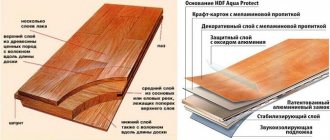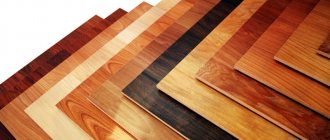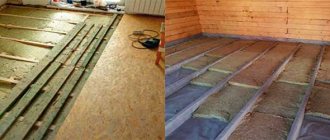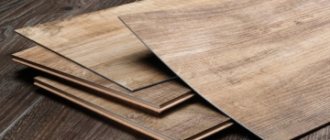Replacing the floor is a headache for the owners, financially burdensome and troublesome. When choosing what to buy, parquet, laminate or linoleum, they always look at how much it costs, how long it lasts and how difficult it is to care for. Parquet flooring immediately falls out of this row - the current prices for the material are beyond the means of the middle class. The indicators of the two remaining types - laminate and linoleum - are often very close to each other. As a result, a dilemma arises: what is better to choose - linoleum or laminate for your apartment or house. In order not to become “Buridan’s donkey”, who died without deciding which armful of hay, left or right, to eat, let’s compare floor coverings and find out which would be best to stop at.
Linoleum and laminate panels.
Advantages and weaknesses of laminate
Manufacturers, sellers and authors of materials about laminate on the Internet give many positive characteristics to this type of building materials. True, some of them look incorrect - you can argue about them:
- High strength. This indicator can only be determined for companies from Belgium and Germany. Moreover, in the same class of laminate, the range of strength is so large that for the best examples of class 31 it can be higher than that of class 33 laminate. Manufacturers from Russia and China indicate only the class. Therefore, it is impossible to say unequivocally that the material being purchased is durable - you can buy lamellas with very low strength characteristics;
- Long service life. This indicator depends on wear resistance, and, firstly, it can be different, and, secondly, with the same indicator value it provides in one case a maximum of 7 years of operation, in the second - more than 20 years. This is explained by the measurement technique;
Conclusion: high strength and wear resistance are inherent only in expensive brands of laminate. In the middle price sector there is complete uncertainty - you can buy both.
- A wide selection of textures, colors and sizes, allowing you to satisfy the most sophisticated tastes. At the same time, laminate can visually change the size of the room: lengthen or expand, highlight separate zones in the room;
- Easy and understandable installation technology;
- High resistance to fading - a special film is applied that does not transmit UV rays;
- Laminate flooring does not require special care: no need to sand, varnish or wax. You can clean the dirt with a damp cloth or paper napkin;
- Laminate boards are well resistant to sharp heels, heavy furniture, falling objects, and cigarette ash;
- Ease of transportation;
- Excellent withstands abrasive loads;
- A price accessible to a wide range of buyers.
At the same time, there are several statements that are completely untrue:
- It has good noise absorption - the opposite is true: it resonates and amplifies sounds;
- Retains heat - cannot be used as insulation due to its high thermal conductivity.
Manufacturers and sellers do not like to talk about the disadvantages of laminate flooring. And they are also significant:
- The presence of up to 80% natural wood in a laminate does not in any way guarantee its safety for health. The remaining 20% are phenol-formaldehyde resins, which release harmful formaldehyde (chemical formula HCHO) into the air. This process occurs especially actively when installing a “warm floor” system;
- One of the main disadvantages is low moisture resistance. It swells when exposed to water, especially when it floods from above or breaks pipes in the apartment. This is a complete replacement of the floor and significant financial costs. The same result can be obtained in an apartment on the ground floor, if there is a damp basement below, and the waterproofing technology was violated;
- Another significant drawback is that an almost ideal floor screed is required: smooth, strong, dry and clean, with a height difference of no more than 3 mm per 1 m2. It is expensive, time consuming and difficult;
- The ability of laminate to resonate does not bring pleasure to either the neighbors below or the apartment owners. Correctly carried out soundproofing work partially solves the problem, but not completely. Judging by the reviews on the forums, many are trying to get rid of the noise using a thicker backing. But this is a version of the “Trishka caftan”, when, solving one problem, they create several new ones - on a thick substrate, the lamella locks are very quickly destroyed;
- The protective film of the laminate accumulates static voltage from a running personal computer. These are unpleasant sensations when walking and accumulating dust;
- Grease, ink and oil paint spilled on the floor are difficult to remove, which is why experienced professionals do not recommend installing it in the kitchen and children's room;
- Laminate floors are very slippery after wet cleaning, which is almost never mentioned, but traumatologists are well aware of the problem;
- The floor surface feels cold, which is especially unpleasant in the autumn-winter period;
- The slightest failure to comply with the installation technology can lead to deformation of the laid floor due to sudden temperature fluctuations;
- Special care is required when installing furniture. Getting two legs on one panel will inevitably lead to the destruction of the lock.
Cork
How can you fake a cork? Although, with modern technology it is certainly possible. Only this is an expensive material, and counterfeiting it with synthetics and chemicals will also be expensive and unprofitable. So cork floors are also natural. Cork is the bark of the Portuguese cork tree, a very light, porous and incredibly pleasant to the touch material. A cork floor, when pressure is applied to it, for example, when walking on it in heels, shows amazing miracles of elasticity, squeezing, but certainly returning to its original state. And it is the cork layer that is responsible for this miracle, which by nature has such an extraordinary “airy” structure. From a medical point of view, cork flooring is very useful. It perfectly absorbs, and this characteristic property is very favorable for a person, as it allows the legs to rest, while also unloading the spine. This effect of the material is especially useful for people who have ailments in the musculoskeletal system.
Photo: parquetservice.ru
The floor surface is antistatic, silky, and it is very easy to remove any dirt or grease from it. This flooring does not attract dust and is not a source of unpleasant odors. People suffering from allergic diseases can breathe easily and freely in rooms with cork floors. And besides this, this coating is not only an excellent shock absorber, its elastic action and porous structure make any movement around the apartment almost silent. So, by laying cork on the floor, you also get additional noise protection. Try throwing a bunch of keys onto a laminate or parquet floor, and then do the same with a cork - and, as they say, feel the difference. By the way, you will also feel the difference in price. And get ready to spend a lot of money.
Pros and cons of linoleum
The large number of fans of linoleum is explained by its many advantages:
- Having an affordable price (cheap), it is available to almost every family - the most expensive type can be afforded by a family with below average income;
- Long service life - in the “one-room apartments” of Khrushchev’s buildings it could last 20-30 years;
- Easy to install - the simplest installation technology among all types of flooring, so any “nerd” can lay it;
- Easy care - just a mop and a rag; in case of heavy contamination, detergents will help;
- Can be laid on a “warm floor”;
- Absolute resistance to moisture; if immersed in water for several days, the material will retain all its consumer properties;
- High level of grip - it is difficult to slide on it, so it is laid in gyms and public places;
- It is a good insulator - the bottom layer of felt or foamed PVC has a low thermal conductivity;
- Does not conduct noise - the quietest floor covering;
- Large selection of designs and colors - any design idea can be put into practice.
It is difficult to find a building material without flaws. Linoleum also has disadvantages:
- Performance characteristics change with temperature fluctuations: it becomes slippery and moves in waves at sub-zero temperatures, begins to emit substances harmful to health (no longer environmentally friendly) and shrinks at high temperatures (more than 27 degrees Celsius). Low-grade material becomes brittle and prone to deformation in the cold at the dacha;
For reference: linoleum is a chemical material, so it behaves unconventionally when exposed to temperatures: it expands where other materials contract, and shrinks where they expand.
- Constant specific smell when it’s hot outside;
- Inconvenient for transportation - you need freight transport and manual carrying, since the rolls do not fit in the elevator;
- Melts on contact with hot objects, including cigarette ash;
- Damaged (marks remain that cannot be removed) when moving furniture;
Important: in Soviet times, the last drawback was circumvented with the help of lard skins - they were placed under the legs and moved. This method made it much easier to move objects, without leaving marks.
- A visible seam under which dirt constantly accumulates - attempts to glue the joint with tape or special materials do not give a long-term effect: they begin to peel off;
- Sensitive to chemical reagents;
- Requires a level floor screed;
- Traces from black soles are difficult to remove;
- Material of any class will certainly shrink, as a result of which the connecting seam will separate after 3-4 years and begin to hurt the eyes. Therefore, the joints need to be hidden near the walls or use material 5 m wide.
Cigarette marks.
As you can see, when determining which is better - linoleum or laminate, the considered pros and cons do not make it possible to make a clear choice in favor of one type of flooring. Therefore, we will conduct a direct comparison of materials on all technical, technological and economic indicators.
So!
Photo: drevmast.ru
But in the end, in order to choose the flooring correctly, from an environmental point of view, you need to know one more important detail! Any floor covering, be it synthetic, or natural, or even a floorboard in a country house, is always covered with various protective agents, films, mastics, and so on. These coatings give the coatings - forgive the tautology - additional shine, an aesthetic appearance, but most importantly, they provide additional physical protective properties. And after all, we have direct contact with such protective layers, and not with the raw material itself! It turns out that it is the protective layers that determine the environmental friendliness of a particular material. As you and I can independently understand, natural raw materials and natural materials are much more neutral in nature than chemical compounds. For example, for parquet, the varnish coating will be less favorable than modern mastics based on natural resins. For humans, of course, too. In general, the most environmentally friendly coating material for parquet floors is beeswax. It is several times more expensive, but it is also incomparably safer. Therefore, pay great attention to the protective layer both when choosing a floor covering and when caring for it.
Comparative analysis of linoleum and laminate boards
To understand which is better, linoleum or laminate in an apartment, let’s compare the flooring and draw conclusions based on the following characteristics:
- price of 1 m2 of material;
- cost of laying 1 m2;
- complexity of the installation process;
- requirements for the floor screed surface;
- possibility of disassembly (dismantling);
- life time;
- fire safety;
- wear resistance;
- resistance to UV rays (fading);
- resistance to static loads;
- resistance to dynamic loads;
- resistance to mechanical damage;
- waterproof;
- thermal conductivity;
- soundproofing properties;
- environmental friendliness;
- ease of care;
- which gets polluted faster;
- use under a “warm floor” system;
- design.
Which is cheaper?
One of the main criteria for choosing a floor is its price. Therefore, you first need to decide what is cheaper - laminate or linoleum in the apartment. If we take budget building materials, then linoleum is about 2 times cheaper than laminate - the price of linoleum starts from 120 rubles/m2, laminate boards - from 260 rubles/m2.
In the premium class, the difference is even greater - 2.3 times: linoleum can be bought for 360-600 rubles/m2, laminate - for 840-1400 rubles/m2. Conclusion: in this comparison, linoleum has an undoubted advantage.
Which is cheaper to install?
In addition to the price of the material itself, the cost of laying the floor has a significant impact on the owner’s wallet. To install laminate directly, you can hire a team of builders for 250-400 rubles/m2, plus 150 rubles/m2 for laying waterproofing and underlayment. Linoleum flooring will cost from 90 rubles/m2.
Conclusion: laying laminate flooring is expensive, so linoleum has the advantage. However, when doing the work yourself, the materials have almost parity - to lay the lamellas you need a tool that you need to either buy or rent.
What is more difficult to lay?
Laying the flooring in both cases is quite simple - even a beginner can handle the job. However, the labor intensity of the work and its complexity still make a difference - laying laminate flooring will require good knowledge of technology, attentiveness, ability to work with tools and much more time for the entire process. Conclusion: the indicator is in favor of linoleum, although with a slight advantage.
Which material has simpler requirements for floor screed?
Linoleum and laminate require an equally flat base surface on which to lay. Any unevenness affects the surface of the material - linoleum is wiped off in such places, and the locks of the laminate are destroyed.
The effect of bumps up to 3 mm in height on the floor covering is eliminated by using a backing for the laminate, felt or PVC film for linoleum (glued to the bottom of the material). For large differences in height, it is necessary to carry out additional leveling of the screed. Conclusion: the materials are completely equal.
Which is easier to dismantle?
Linoleum can be removed in a few minutes. You will have to tinker with the laminate - very often the locks during operation are firmly glued together and are difficult to dismantle. Conclusion: removing linoleum from the floor is simpler and easier.
Which is more durable?
According to the service life declared by the manufacturers, both materials have an approximate parity of 10-15 years. However, during operation, linoleum is easier to damage: scratches from sharp objects, melted areas from an iron or ash from cigarettes, traces from moving furniture and black rubber soles.
Linoleum can break through under strong pressure, retain an impact mark for a long time, etc. The listed reasons sharply reduce its service life. Laminate is not so afraid of dynamic and static loads, it is not afraid of sharp objects - it is difficult to scratch it. Conclusion: for the first time, laminate has, at least a small, advantage - it is more practical.
Traces from heavy furniture.
Which material burns worse?
Linoleum is made from chemical components. Therefore, its ability to burn is much higher. The inscriptions on the packaging also remind us of this, where the flammability class is indicated by the letter “G” (flammability) and numbers from 1 to 4 (class). Another problem: when linoleum burns, toxic substances are released, as is reminded by the classifiers designated T1-T4 (increasingly).
Laminate does not support an open flame - it smolders. However, it also releases harmful substances, however, in small quantities. All this served as the basis for laminate manufacturers not to indicate flammability and toxicity classes for their products. Conclusion: in terms of fire safety, laminate has an undoubted leadership.
Which material has higher wear resistance?
In terms of this indicator, the materials are approximately equal - in residential premises they cannot be wiped while walking. When exposed to abrasive materials, they also quickly become unusable - traces remain that cannot be removed. Conclusion: the indicator can be ignored - none of the materials has an advantage.
Which burns out less?
There is no strict connection to a specific type of material. Everything is determined by the absence or presence of a special film (by the way, whether it is on the surface of the material or not does not affect the price) that protects the decorative layer from ultraviolet radiation. It is difficult to independently determine the presence of a protective film. Therefore, ask consultants or gym managers. Conclusion: the materials are completely equal.
Which is stronger
Here we compare the materials according to three indicators: resistance to static and dynamic loads, as well as mechanical damage. In all three characteristics, the undoubted leader is laminate. When installing furniture, it is important to prevent two or more legs from falling on one laminate board - the locks will be destroyed.
Linoleum can withstand heavy furniture, but footprints remain almost until the end of its service life. Sharp objects leave scratches that cannot be removed. When an office chair with legs is used for a long time in one place, abrasion appears on the linoleum. Conclusion: laminate is definitely stronger.
Which material has higher moisture resistance?
There is no need to go into details here: linoleum will withstand not only accidentally spilled water, but also a real flood. Laminate is hygroscopic - damp weather is enough for it to become unusable. Conclusion: if we are talking about a room with high humidity or frequent flooding, then only linoleum is needed here.
Which is warmer
Here, contrary to popular belief, linoleum is in the lead. A thin chemical material conducts heat less well than a thicker wood fiber laminate. The situation is evened out by thermal insulation of the floor under the laminate. Conclusion: linoleum retains heat better, although, as noted on the forums, it is colder in tactile sensations.
Which is quieter?
Laminate is a very good resonator. Almost everything that happens in the apartment can be heard by the neighbors below. Such a floor also disturbs the residents themselves - sounds scatter well throughout the rooms. Carrying out perfectly executed soundproofing work solves the problem by 90 percent. For example, the clicking of thin heels cannot be drowned out no matter how hard you try.
Linoleum not only absorbs all types of extraneous noise well, but also does not conduct apartment sounds to the walls and ceilings. He is the most silent floor. Conclusion: linoleum is the undisputed leader in noise absorption.
Which is more harmful?
Regarding the health hazards of the analyzed materials, the situation is a little confusing. Under optimal operating conditions, each material is environmentally friendly, so much so that a small child can play on both laminate and linoleum without any health consequences. When the temperature regime deviates from the optimal one, for example, upward, both materials begin to release harmful substances into the air. But we emphasize that this is under force majeure circumstances.
Conclusion: despite the chemical components included in the materials, they are both safe for human health.
Which is easier to wash?
It is very easy to care for both types of material. If necessary, detergents can be used. The only limitation: laminate flooring must be washed with a wrung-out cloth. Yes, black shoe marks on linoleum can be easily removed with a cotton swab soaked in acetone. Conclusion: there is complete equality here.
Which gets dirty faster?
Due to the accumulation of static electricity, the laminate becomes dirty faster. But this minus, oddly enough, has its own plus: there is less dust on the walls, shelves, lamps and various decorative elements, which is much easier to wipe from the floor than from the items listed above. Conclusion: paradoxically, experts give preference on this issue to laminate, although it gets dirty faster.
What type of material can be laid on a “warm floor”
“Warm floors”, which have become popular recently, can work in conjunction with both laminate and linoleum. Manufacturers directly indicate that they can be laid on “warm floor” systems. Conclusion: there is no advantage in this indicator for any type of sex.
What's more beautiful
The varied designs of laminate and linoleum have led to the fact that it is often visually difficult to determine the type of flooring. Different colors, textures, patterns allow you to implement the most unexpected solutions for flooring when decorating the interior of a room and apartment as a whole. Conclusion: both materials do not create problems for the designer.
It is difficult to determine the type of material by external signs.
To conclude the topic of which is better, laminate or linoleum, here is an expert’s opinion: linoleum is more of a kitchen type of floor, although it can be installed in any room of the apartment, but it is less desirable in the bedroom and children’s room due to a slightly noticeable odor. In addition, it is ideal for loggias and balconies. Laminate was conceived and produced for residential premises - it has a more presentable appearance. It is undesirable in the kitchen and unacceptable in the bathroom.
Material prices
Prices for laying flooring per 1 m2 vary: for laminate from 120 to 550 rubles, for linoleum from 80 to 300 rubles.
What will cost more: laminate or linoleum? Let's compare prices.
Price table for linoleum
| Price | Class | Thickness in cm | Material of manufacture | Price per 1 m2 in rubles |
| Inexpensive | Domestic | From 0.2 to 0.4 | PVC | 120 – 390 |
| Commercial | From 1 to 1.7 | Rubber | 600 – 900 | |
| Semi-commercial | From 0.2 to 0.4 | Alkyd | 230 – 320 | |
| Average | Domestic | From 1.5 to 0.3 | Colloxylin | 240 – 550 |
| Commercial | From 1 to 2.5 | Rubber | 515- 580 | |
| Semi-commercial | From 0.2 to 0.4 | Alkyd | 480 – 525 | |
| Premium | Domestic | From 0.2 to 0.5 | PVC | 365 – 600 |
| Commercial | From 1 to 4 | Rubber | 1600 – 3000 | |
| Semi-commercial | From 0.2 to 0.4 | Alkyd | 520 – 650 |
Laminate price table
| Price according to rep. | Class | Size in mm | Price per 1 m2 in rubles |
| Inexpensive | 31-33 | 195×1215 | 265 – 385 |
| Average in price | 31-33 | 165×1215 | 285 – 890 |
| Premium | 31-33 | 400×800 | 340 – 1400 |
Which is better and in which room?
Before we begin to consider the question of what is better and in which room, let’s look at two particular issues.
- In new buildings, linoleum should always be laid on the ground floor. While the house is not in use, it is difficult to predict what the basement will be like: damp or dry. Only when replacing the floor can you lay laminate flooring. If dampness comes from the basement, you will have to do double waterproofing: under the screed and along its top.
- A similar situation is in a private house. Until there is clarity on the humidity under each room, linoleum should be on the floor.
Attention: in practice, there are frequent cases of disruption of water exchange at a construction site when pouring the foundation, as a result of which increased humidity suddenly appears in a dry area under the building.
Returning to the main question, we note that laminate is preferable in the living room . This is explained by the status of the premises: the central place in the apartment (house), where guests gather for holidays and get-togethers are held. It is here that the level of wealth and taste of the owners can and should be demonstrated, which is possible with a presentable laminate.
It is also better to lay laminate panels in the bedroom They are odorless, look beautiful, do not collect dirt - there are no static charges. In the hallway and corridor , linoleum is better - dirt from the street is easier to wash away. However, the presence of mats on both sides of the door allows you to successfully use laminate flooring in these rooms.
In the kitchen and bathroom , linoleum looks more functional - high humidity and constant water on the floor are not suitable for laminate. On the balcony there is no alternative to linoleum - regular wetting during rain excludes the option of laminate, but in the loggia you can use any of the materials in question.
Parquet
Piece or stacked parquet is really a piece of material, why make it from synthetics if it will still be relatively expensive? Of course, this is the most natural, natural material made from natural raw materials. It is literally solid wood. You just need to remember that parquet is often made from special types of wood, which is very valuable and requires respect and careful care as a noble material. A special catch: despite the fact that our modern houses and apartments are much more convenient, practical and comfortable than previous homes, all natural materials do not feel very comfortable in them, especially over time. The fact is that concrete floors, as well as concrete walls, do not “breathe”, but only absorb moisture. This is especially true during the heating season, when the air in the apartment becomes dry even despite the humidifiers that civilized society uses everywhere today. And windows made of plastic and metal with their new sealed profiles make our microworld even more clogged. Under these conditions, if you have noticed, indoor plants do not always grow well, furniture cracks and drys out, and natural parquet “dies” over time. And to prevent this, you need to fence off and isolate the parquet from the concrete floor by making an additional screed, on which you must then lay a moisture-resistant substrate, preferably plywood.
Photo: moscow.olx.ru
We confidently classify parquet as one of the most natural – and therefore the most environmentally friendly floor coverings. But like all natural materials, it is not cheap, and also requires special attention and careful handling.
How to compare which is better for the floor: linoleum or laminate?
It is difficult to choose one type of coating, since there are many parameters to evaluate, and it is difficult to understand which one is the most important.
To make it easier, you first need to figure out how laminate differs from linoleum:
- Laminate is a hard board on which several layers of coatings are applied. It is cut into individual tiles - lamellas, which are given a shape that allows you to assemble a single sheet with minimal gaps without the use of glue.
- Linoleum is a soft base with a coating applied to it. It is almost impossible to make the joints of two pieces invisible, so they try to choose the width of the roll so that the floor in the room can be covered in one piece.
To understand how laminate differs from linoleum, and which is better, you need to select criteria that are important in a particular case and that are convenient to compare. We can talk at length about the materials used in the production of both coatings, but, frankly speaking, this is not significant for the user. More important are the characteristics they give to the product and its performance.
Conclusion
: for operation, the main differences between the materials will allow you to choose between laminate and linoleum - one is hard and made of parts, the other is soft and solid. It is these properties that will influence other characteristics.











